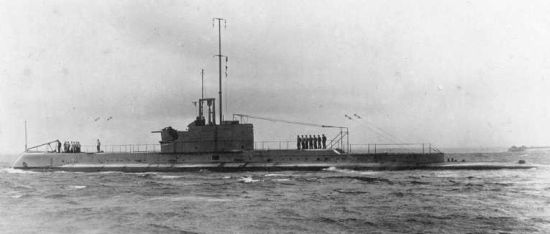- Author
- Smith, Peter
- Subjects
- History - WW1
- Tags
-
- RAN Ships
- HMAS Otway I, HMAS Oxley I
- Publication
- March 2003 edition of the Naval Historical Review (all rights reserved)
With kind permission of the Submarine Association of Australia magazine ‘In Depth’
HMS Oxley was the first British submarine casualty of the War and the circumstances of her loss were deliberately kept a mystery for many years. This account is taken from the original Board of Enquiry and other official papers, with assistance from the Royal Navy Submarine Museum at Gosport, UK.
IN 1924 THE AUSTRALIAN GOVERNMENT ordered two new patrol submarines of the Oberon class that the RAN designated as the ‘Oxley’ class, which were commissioned in 1927 as HMA Ships Oxley and Otway. Both made a grand entrance into Sydney Harbour on 14 February 1929.
Due to the restrictive monetary problems of the Depression, the Navy found it could not maintain the cost of keeping the boats in reserve, so the Australian Government handed over the submarines as a gift to the British Government. On 10 April 1931 the submarines were recommissioned into the Royal Navy as HM S/Ms Oxley and Otway and left Sydney, to eventually join the First Submarine Flotilla in the Mediterranean. It would be thirty six years before Australia would own another submarine.
Prior to the outbreak of war, Oxley, under the command of LCDR Harold G. Bowerman RN, had been moved from the Mediterranean and was attached to the Second Submarine Flotilla based on the depot ship HMS Forth, at Dundee.
Prior to the declaration of war against Germany, five submarines of the Second Flotilla were ordered out and proceeded to their patrol positions on the Obrestad line off Norway on 24 August 1939. When war was declared on 3 September all British submarines were in their combat patrol sectors.
At 2055 on 10 September 1939 Fate delivered a devastating hand. Unfortunately for Oxley, she had drifted out of her patrol sector and surfaced close to the British submarine HM S/M Triton (LCDR H.P. de C. Steel RN).
Triton had surfaced at 1955 and had fixed a position off the Obrestad light, set a slow zigzag patrol and began charging the batteries. Having decided that the area was clear and the lookouts posted, Steel handed over the submarine to the Officer of the Watch (OOW) and went below, with orders that he was to be called if anything unusual appeared. At 2045 the captain was called to the bridge when an object in the water could be seen very fine on the port bow. Steel ordered that the signalman be sent to the bridge and started main motors at once. Torpedo tubes 7 and 8 were also ordered prepared for firing. It was at this time that the object was recognised as a submarine low in the water. The signalman on the bridge was ordered to make a challenge with the box lamp, which he made slowly. After 20 seconds when there was no reply he was ordered to make a second challenge. Again, no reply. After a short interval a third challenge was made, with still no reply. During this period, Steel had wondered if the boat was Oxley and studied the silhouette, but could not distinguish what type of submarine it was, as it was trimmed down low and he could not see the bow or shape, and the conning tower did not seem to be that of Oxley.

Having tried to communicate with the submarine, and with no reply to their three challenges and no response to the fourth challenge of three green flares fired from a rifle grenade, Steel counted slowly to 15 and then decided that it was a German U-boat and ordered the torpedoes be fired. Tubes 7 and 8 were discharged at three second intervals. At 40 seconds after firing an explosion was heard, which indicated a hit. Triton moved into the area to investigate and from the sea came cries for help. With the use of the light from the Aldis lamp three men were seen floundering in oil and debris.
In Triton’s control room was LEUT Guy Watkins when a directive for three men with lines was ordered topside. After relaying the order he joined the men on the bridge. He and the OOW, LEUT Harry Stacey, quickly put lines around themselves and entered the water to rescue Oxley’s captain and an able seaman. The third person in the water, LEUT F.K. Manley RNR was seen to be swimming strongly when he suddenly sank from view. His body and those of other members of Oxley’s crew were never found.




